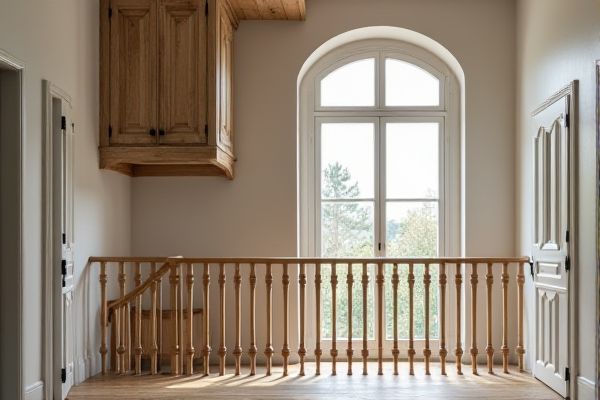
Closed balustrades provide a solid, continuous barrier for enhanced safety and privacy, while open balustrades feature gaps or spaces between balusters, allowing for better visibility and airflow. Explore the rest of the article to determine which balustrade style best suits your design and functional needs.
Table of Comparison
| Feature | Closed Balustrade | Open Balustrade |
|---|---|---|
| Description | Solid panels or closely spaced elements blocking visibility | Spaced posts or rails allowing visibility through gaps |
| Privacy | High privacy | Low privacy |
| Safety | Enhanced safety with no gaps for climbing or falling | Moderate safety; gaps present potential risks |
| Visual Appeal | Solid, modern, or traditional look | Open, airy, and decorative appearance |
| Material Options | Glass panels, wood panels, metals | Wood posts, metal spindles, glass with gaps |
| Maintenance | Lower maintenance; fewer elements to clean | Higher maintenance; more parts to clean and inspect |
| Cost | Typically higher cost due to materials | Generally lower cost |
| Use Cases | Balconies, staircases needing privacy and safety | Balconies, decks emphasizing view and openness |
Understanding Closed and Open Balustrades
Closed balustrades feature solid panels or closely spaced elements that provide a continuous barrier, enhancing safety and privacy, while open balustrades consist of spaced balusters or rails allowing better visibility and airflow. Your choice between closed and open balustrades depends on the desired aesthetic, safety requirements, and level of openness for your space. Closed balustrades are ideal for child-proofing and modern designs; open balustrades suit traditional settings and locations where maintaining sightlines is important.
Key Differences Between Closed and Open Balustrades
Closed balustrades feature solid panels or closely spaced elements that provide greater privacy and safety, ideal for families or high-traffic areas. Open balustrades consist of widely spaced spindles or bars, enhancing visibility and airflow, making them suitable for decorative or scenic spaces. Your choice depends on balancing safety requirements, aesthetic preferences, and the desired level of openness or enclosure.
Aesthetic Impact on Interior and Exterior Design
Closed balustrades create a sleek, seamless look that enhances modern interior and exterior designs by providing a solid visual barrier and a sense of privacy. Open balustrades offer a lighter, more airy aesthetic, allowing natural light to flow through and creating a sense of spaciousness in your living spaces. Choosing between closed and open balustrades significantly influences the ambiance, with closed designs emphasizing solidity and intimacy, while open styles promote openness and connection to the surroundings.
Privacy and Light Flow Considerations
Closed balustrades offer enhanced privacy by providing solid panels that block visibility, making them ideal for spaces where seclusion is a priority. Open balustrades, featuring gaps or spindles, allow for greater light flow and air circulation, enhancing brightness and openness in your environment. Your choice between closed and open balustrades will depend on the balance you seek between privacy needs and natural light access.
Safety and Building Code Compliance
Closed balustrades provide enhanced safety by minimizing gaps, reducing the risk of children or objects falling through, and better meeting stringent building code requirements in residential and commercial settings. Open balustrades, featuring spaced balusters or rails, may comply with codes if designed to maintain proper spacing and height, but require careful adherence to local regulations to ensure safety standards are met. Your choice between closed and open balustrades should prioritize compliance with relevant building codes and the specific safety needs of the environment.
Installation and Material Options
Closed balustrades typically require more precise installation due to their encompassing panels, often made from glass, metal, or wood, providing increased safety and privacy. Open balustrades, featuring spaced balusters, allow simpler installation with versatile materials like wrought iron, stainless steel, or timber, offering a more airy aesthetic. Your choice depends on desired durability, maintenance, and style preferences, as closed designs support varied materials for a solid barrier while open ones prioritize traditional and modern material blends.
Maintenance Requirements
Closed balustrades require less frequent cleaning since their solid panels prevent dirt and debris from accumulating in gaps, reducing maintenance time and effort. Open balustrades, featuring spaces between balusters, demand more regular cleaning to remove dust, leaves, and cobwebs trapped within the open design. Materials like glass or metal used in closed balustrades often resist weathering better than wooden open balustrades, impacting long-term upkeep.
Cost Comparison: Closed vs. Open Balustrades
Closed balustrades generally incur higher costs due to the increased material usage and labor involved in creating solid panels or intricate designs, which provide more privacy and a contemporary aesthetic. Open balustrades, featuring spindles or glass panels, tend to be more budget-friendly as they require less material and simpler installation processes while offering an airy, transparent look. Price differences vary based on materials like wood, metal, or glass, with custom designs further impacting the overall expense between closed and open balustrade options.
Popular Applications for Each Type
Closed balustrades are commonly used in modern residential and commercial buildings where privacy and safety are prioritized, such as balconies, staircases, and terraces. Open balustrades are popular in garden spaces, decks, and stairways where aesthetic appeal and unobstructed views enhance the environment, often featuring glass panels or decorative metalwork. Choosing between closed or open balustrades depends on the desired balance of security, visibility, and architectural style.
Choosing the Right Balustrade for Your Space
Closed balustrades offer enhanced safety and privacy, making them ideal for homes with children or outdoor spaces requiring wind protection. Open balustrades provide a more airy, transparent look, perfect for maximizing views and creating a spacious feel. Your choice depends on balancing aesthetic preference, safety needs, and the specific functional requirements of your space.
 homyna.com
homyna.com